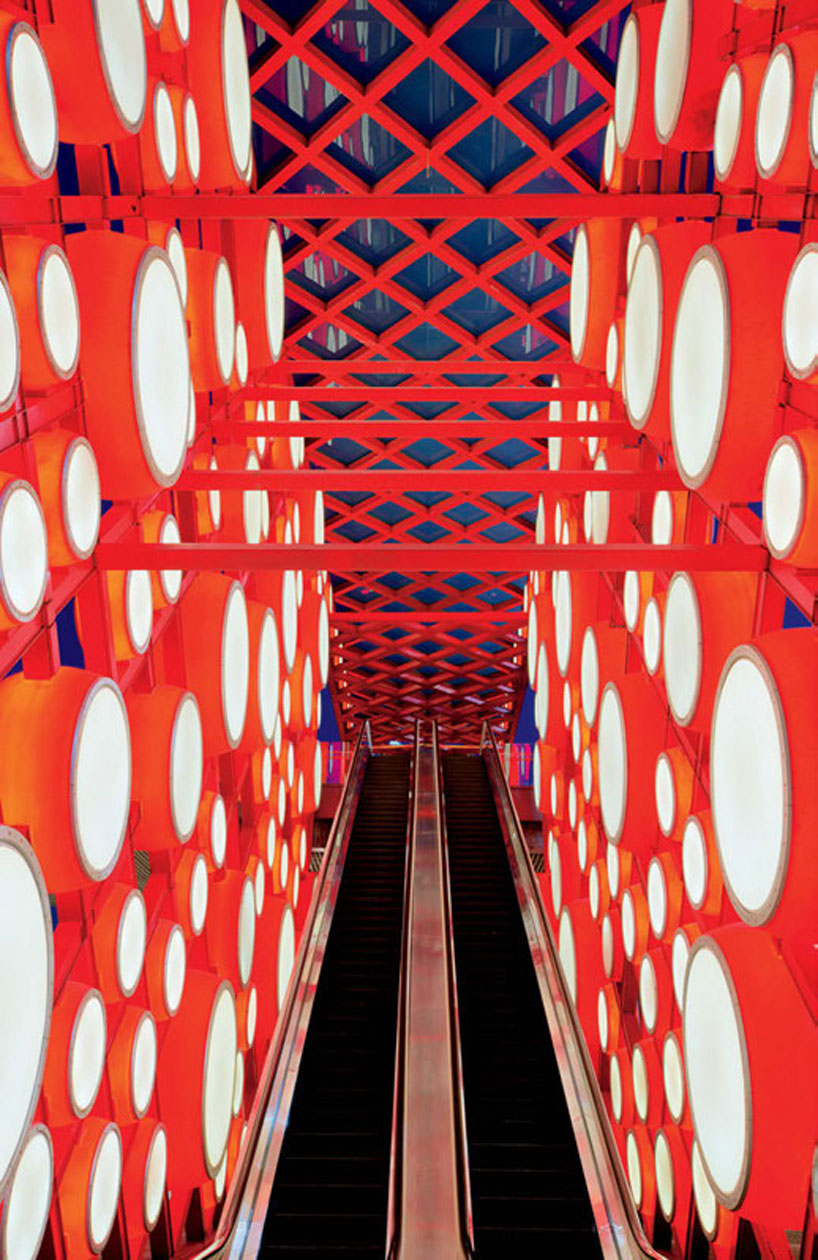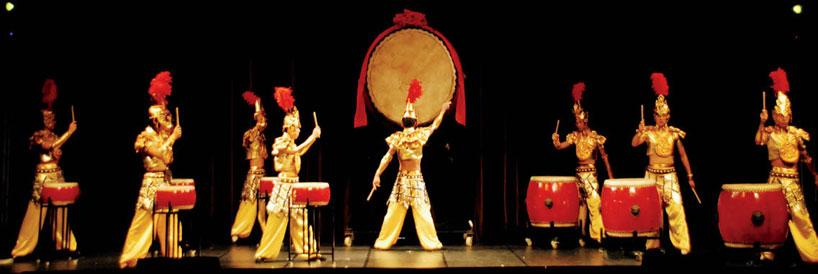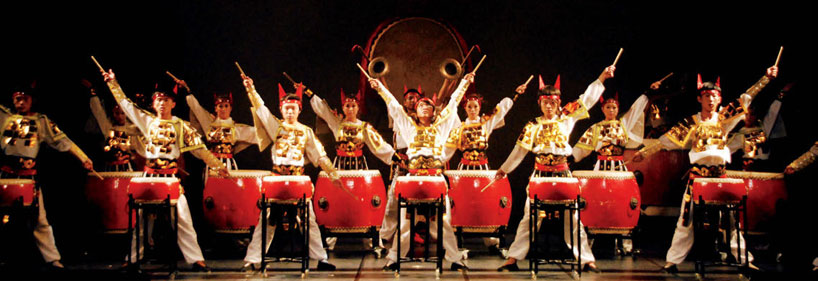
Jiangzhou drum music: vigor from the ancient times
Jiangzhou drum music was famous since the early Tang Dynasty (618-907). For thousands of years local farmers spend most of their spare time playing the drum. Nowadays the farmer drum players have gradually moved into the commercial performance market by establishing many drum music troupes.

In winter days, one would find almost everything in Xinjiang County of Shanxi Province presents the yellow color of clays. The region, which lies at the intersection of three provinces of Shanxi, Shaanxi and Henan, perfectly showcases the topography of Loess Plateau in China. In such a background, four girls holding drumsticks in hands were standing in a rural courtyard and performing Rolling Walnuts for Grandpa Wang. And the courtyard became bright and dynamic because of the four red drums.
For thousands of years in Xinjiang, called Jiangzhou in the past, local farmers on the yellow land spend most of their spare time playing the drum, which is the closest partner in their life. “Drum is an imperative component in the band”. The dynamic and masculine drum music is the echoing sound of the vast land.
Many classic programs of Jiangzhou drum music have won numerous first prizes in the country’s major folk music/dance competitions, including the National All-star Competition. In 2002, Jiangzhou drum music was listed by UNESCO into the List of Masterpieces of the Oral and Intangible Heritage of Humanity as “the world intangible cultural heritage”. Discovery Channel even made a feature program about the Jiangzhou drum music.
Of all the percussion instruments, the drum has the longest history and largest variety. The many kinds of drums in the world, such as the waist drum, the hand drum and the Taiping drum among others, produce quite different styles of music. Nevertheless, they share the same features such as the strong sense of rhythm and explicit emotional expressions. The drum was recorded in the ancient history of China. It is said that about 5,000 years ago when the Yellow Emperor was fighting against Chi You (a mythical tyrant as the major opponent of Yellow Emperor), “the Yellow Emperor killed Kui (a one-legged monster), peeled its skin and made a drum, which could be heard a few hundred miles away”. The oldest skin drum ever found is believed to be the Tuo (the ancient name for the Chinese alligator) drum which was unearthed in the relics of Tao Temple in Linfen of Shanxi Province. It reveals that people began to use drums made of crocodile skins in the late Neolithic Period.

Drums producing dynamic sound are not just used on battlefields. They are also deemed as heaven-reaching holy artifacts used in sacrifice ceremonies. Since they became a musical instrument, they have been known as the “head of all instruments”. In Buddhist temples, bells are struck in the morning and drums in the evening. In common people’s wedding and funeral ceremonies, drum music is often played. The drum music in different regions often has its own characteristics, such as the “Fuzhou Shifan Music”, “East Zhejiang Gong and Drum Music” and “Xi’an Drum Music”. Sometimes, the drum music even differs within the same region. For instance, Shanxi Province has multiple types of drum music and Jiangzhou drum music (also known as Jiangzhou Grand Drum) is one of the best known as the Most Excellent of Shanxi drum music.
Rolling Walnuts is one folk piece out of the many pieces of Jiangzhou drum music. The rhythm of the drum beat, sometimes slow and sometimes quick, imitates the sound of walnuts falling from the house roof to the ground. This piece is most played in the harvesting season of autumn in Xinjiang County. But this time, the four girls’ performance surprised Grandpa Wang greatly. Playing solely or collectively, the four girls played with the drumsticks rotating in their hands at intervals. The numerous hand tricks captured the attention of Grandpa Wang, who is a famous senior drum player himself.
Eight hundred and fifty km away in Beijing, curtains on the stage of Poly Theatre were opened slowly. Following a striking on a drum, the sound of driving carriages, riding horses and running people suddenly swept over, taking the audience back to the ancient battlefield in 620 A.D. All of a sudden, the triumph music was on, signaling the victory of the Tang army. The audience couldn’t see any battlefield scene on the stage. Instead, they just saw the 27 drums of different sizes and sweaty faces of the drum players. The audience, who had just travelled back from the history, burst into thunderous applause and cheers. Some even stood up to wave their arms and stamp their feet. And the scene is the show of Jiangzhou Drum Music Troupe playing the King of Qin Breaks through the Battle Line, which was designated as the national music of Tang Dynasty. It recorded the important battle ensuring the stability in early Tang Dynasty. Over 1,000 years have passed and the music is still exciting and stimulating.

Though expert in producing rhythm, drums always find storytelling a difficult task. For a long time, solo drum playing is seldom tried, not to mention a program made solely with drums. However, Jiangzhou drum playing is an exception with its “complex striking skills”. The Rolling Walnuts tells people’s pleasure at the harvest and King of Qin Breaks through the Battle Lineproduces the greatest splendor that almost “shakes the land and mountains”. Even more, two players with two drums can vividly demonstrate a scene of an ox fighting against a tiger, or tell a humorous story about the mice in the wedding ceremony being scared by an uninvited cat.
The secret of “complex striking skills” lies in the players’ ability to produce sound by striking or beating all parts of the drum. Not only the drum surface, but also the drum stand, nails, rings and edges can be beaten. And the drumsticks can beat each other. The diversified percussions, accompanied by the body gestures and facial expressions of the drum players, produce the subtle and gentle atmosphere in the rough and dynamic music. All these features have created the unique drum music language of Jiangzhou.
In the past few decades, the farmer drum players from Jiangzhou have gradually moved into the commercial performance market by establishing many drum music troupes.
In 1980, Mr. Wang Qin’an, who was then Director of Xinjiang County Culture Center, set up a drum troupe by selecting farmer drum players from 13 towns and villages. Each day, they would practice playing drum music for 15 hours, with each player striking 150,000-200,000 times a day. In 30 days’ time, they broke more than 400 solid wood drumsticks. These farmer drum players have been invited to give performances on professional stages in other Chinese cities and even other countries. In September 1995, Jiangzhou Drum Music Troupe gave its first overseas performance in Aarhus of Denmark, winning 5-minute long cheers from the audience. The players responded to the curtain call for 6 times and returned to the stage for 4 times. Even so, the audience still refused to leave. According to the United Daily News of Taiwan, “The audience stood up and stamped their feet on the ground. They were totally in a crazy state when cheering the performance”. And Music and Politics in Denmark said, “The audience would not allow the Chinese Drum Music Troupe to leave the stage. A successful performance often gets 1 or 2 rounds of warm applause. But no one can reject 4 or even 5 rounds of thunderous applause”. The Mayor of Aarhus said the city’s Music Hall had never seen so large an audience and such a long time of applause with the whole audience standing.

Chairman Feng Jicai of Chinese Folk Literature and Art Society once said that listening to the drum music could “burn the blood”, and “the players were beating my heart instead of the drum”. Numerous people, both Chinese and overseas, admire the Jiangzhou drum music. However, the Jiangzhou drum music is doing very well in retaining the honesty and simplicity from the yellow land. They keep revising and making new pieces and skills. For instance, more details have been added into the Rolling Walnuts with more refreshing and exciting stage gestures. Furthermore, the drum itself is also experiencing “reformation”.
Since 2008, Shanghai East Jiangzhou Drum Music Troupe has been surprising the drum music community by making exceptional innovations such as water drums, fluorescent drums and crystal drums. In the laser lighting, the players swing the fluorescent drumsticks with their hair dancing and water spraying in the air. All the audiences are amazed at the music and scene. Today, such performance has become a showy trend, going beyond the Jiangzhou drum music. It can be seen on all kinds of performance stages and even in bars.
Except for the above-mentioned novel drums, people have also created blue-white porcelain drums and jadeite drums, etc. All these novel drums are refreshing while retaining the strong Chinese traditions. “Tradition is good and worth the practice of players. However, it is not enough to play in the traditional way”. Though having lived in Shanghai for years, Director Quan still has the honesty and frankness of Shanxi men. “The elderly players silently keep their unique understanding of drum music and live on the barren land for their whole life. But what should we do? Where should the young players go? I wish to transform the ancient drum music into the new symbols of fashion. And I want to have more people listen to the drum music of modern fashion where echoes travelling from the distant past can be heard”
More about chinese music in ConfuciusMag:
- Peking opera: Sharing Chinese Culture with the World
- Nanyin: A “Living Fossil” of Ancient Chinese Music
- Zheng Xiaoying: Cultural symphony
- Gan opera: Chen Li and her dream

























No hay comentarios:
Publicar un comentario